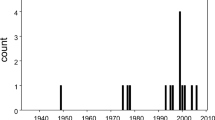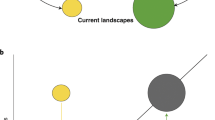Abstract
Purpose of the Review
The loss or gain of biodiversity and/or ecosystem functions and services can occur with a substantial delay following landscape change. We have first revisited the key concepts used to refer to those delayed ecological responses to landscape change and then reviewed the literature aiming to summarize (i) methodological approaches used to empirically evaluate the existence of delayed ecological responses, (ii) empirical evidences of delayed ecological responses, and (iii) current understanding of the main mechanisms that can explain those delayed responses.
Recent Findings
We identified that key concepts used to refer to delayed ecological responses are very confusing as many different terms are used to refer to a single delayed ecological response. So, we propose here a unified vocabulary to support future research. Our review showed that there is plenty of empirical evidence that delayed ecological responses to landscape change are common in nature. However, current knowledge is mostly restricted to biodiversity responses to adverse landscape changes. Few studies have investigated for ecosystem functions and/or services delayed responses or delayed ecological gains after landscape structure improvements such as increase in habitat amount. We verified that some progress occurred in recent years. We identified the use of three new methodological approaches to empirically evaluate the existence of delayed ecological responses, and we also verified an increase in our understanding about the mechanisms that explain delayed ecological responses. As expected, we observed high levels of support for delayed ecological responses in landscapes that have undergone recent changes and for habitat specialist species. Other hypotheses have been less frequently tested. Some of them have a low level of support (no clear relationship between strength of landscape change and delayed responses), while others have a good level of support but still need more evidences (relationships between species longevity and dispersal capability with delayed responses).
Summary
Our understanding about delayed ecological responses to landscape change is still at an early stage and seems to be increasing slowly while human-altered landscapes are increasing rapidly worldwide. There are still important knowledge gaps to be filled. Beyond providing better support for some explanatory hypotheses, we still need to explore (1) ecosystem functions and services delayed responses to landscape change, and (2) the delayed ecological gains after positive landscape changes.




Similar content being viewed by others
References
Hanski I. Extinction debt and species credit in boreal forests: modelling the consequences of different approaches to biodiversity conservation. Ann Zool Fenn. 2000;37:10.
Kuussaari M, Bommarco R, Heikkinen RK, et al. Extinction debt: a challenge for biodiversity conservation. Trends Ecol Evol. 2009;24:564–71.
Isbell F, Tilman D, Polasky S, Loreau M. The biodiversity-dependent ecosystem service debt. Ecol Lett. 2015;18:119–34.
Valiente-Banuet A, Aizen MA, Alcántara JM, et al. Beyond species loss: the extinction of ecological interactions in a changing world. Funct Ecol. 2015;29:299–307.
Vellend M, Verheyen K, Jacquemyn H, Kolb A, Van Calster H, Peterken G, et al. Extinction debt of forest plants persists for more than a century following habitat fragmentation. Ecology. 2006;87:542–8.
Hanski I, Ovaskainen O. Extinction debt at extinction threshold. Conserv Biol. 2002;16:666–73.
Banks-Leite C, Pardini R, Tambosi LR, et al. Using ecological thresholds to evaluate the costs and benefits of set-asides in a biodiversity hotspot. Science. 2014;345:1041–5.
Ellis CJ, Coppins BJ. 19th century woodland structure controls stand-scale epiphyte diversity in present-day Scotland: epiphyte extinction debt. Divers Distrib. 2007;13:84–91.
Brook BW, Sodhi NS, Ng PKL. Catastrophic extinctions follow deforestation in Singapore. Nature. 2003;424:420–3.
Lira PK, Ewers RM, Banks-Leite C, Pardini R, Metzger JP. Evaluating the legacy of landscape history: extinction debt and species credit in bird and small mammal assemblages in the Brazilian Atlantic Forest. J Appl Ecol. 2012;49:1325–33.
Tambosi LR, Martensen AC, Ribeiro MC, Metzger JP. A framework to optimize biodiversity restoration efforts based on habitat amount and landscape connectivity: optimizing restoration based on landscape resilience. Restor Ecol. 2014;22:169–77.
Tilman D, May RM, Lehman CL, Nowak MA. Habitat destruction and the extinction debt. Nature. 1994;371:65–6.
Diamond JM. Biogeographic kinetics: estimation of relaxation times for avifaunas of Southwest Pacific Islands. Proc Natl Acad Sci. 1972;69:3199–203.
Nagelkerke KCJ, Verboom J, van den Bosch F, van de Wolfshaar K. Time lags in metapopulation responses to landscape change. In: Gutzwiller KJ, editor. Applying landscape ecology in biological conservation. New York: Springer; 2002.
Cristofoli S, Piqueray J, Dufrêne M, Bizoux J-P, Mahy G. Colonization credit in restored wet heathlands. Restor Ecol. 2010;18:645–55.
Jackson ST, Sax DF. Balancing biodiversity in a changing environment: extinction debt, immigration credit and species turnover. Trends Ecol Evol. 2010;25:153–60.
Essl F, Dullinger S, Rabitsch W, et al. Socioeconomic legacy yields an invasion debt. Proc Natl Acad Sci. 2011;108:203–20718.
Vilà M, Ibáñez I. Plant invasions in the landscape. Landsc Ecol. 2011;26:461–72.
Meyer ST, Ebeling A, Eisenhauer N, et al. Effects of biodiversity strengthen over time as ecosystem functioning declines at low and increases at high biodiversity. Ecosphere. 2016;7:e01619.
Gonzalez A, Mouquet N, Loreau M. Biodiversity as spatial insurance: the effects of habitat fragmentation and dispersal on ecosystem functioning. In: Naeen S, Buner DE, et al., editors. Biodiversity, ecosystem functioning, and human wellbeing: an ecological and economic perspective: Oxford University Press; 2009.
Haddad NM, Brudvig LA, Clobert J, et al. Habitat fragmentation and its lasting impact on Earth’s ecosystems. Sci Adv. 2015;1:e1500052.
Genes L, Cid B, Fernandez FAS, Pires AS. Credit of ecological interactions: a new conceptual framework to support conservation in a defaunated world. Ecol Evol. 2017;7:1892–7.
Gonzalez A, Chaneton EJ. Heterotroph species extinction, abundance and biomass dynamics in an experimentally fragmented microecosystem. J Anim Ecol. 2002;71:594–602.
James KL, Randall NP, Haddaway NR. A methodology for systematic mapping in environmental sciences. Environ Evid. 2016;5:1.
Dullinger S, Essl F, Rabitsch W, et al. Europe’s other debt crisis caused by the long legacy of future extinctions. Proc Natl Acad Sci. 2013;110:7342–7.
Jonason D, Ibbe M, Milberg P, Tunér A, Westerberg L, Bergman K-O. Vegetation in clear-cuts depends on previous land use: a century-old grassland legacy. Ecol Evol. 2014:4287–95.
Krauss J, Bommarco R, Guardiola M, et al. Habitat fragmentation causes immediate and time-delayed biodiversity loss at different trophic levels: immediate and time-delayed biodiversity loss. Ecol Lett. 2010;13:597–60541.
Basnou C, Iguzquiza J, Pino J. Examining the role of landscape structure and dynamics in alien plant invasion from urban Mediterranean coastal habitats. Landsc Urban Plan. 2015;136:156–64.
Dallimer M, Davies ZG, Diaz-Porras DF, Irvine KN, Maltby L, Warren PH, et al. Historical influences on the current provision of multiple ecosystem services. Glob Environ Change. 2015;31:307–17.
Piqueray J, Bisteau E, Cristofoli S, Palm R, Poschlod P, Mahy G. Plant species extinction debt in a temperate biodiversity hotspot: community, species and functional traits approaches. Biol Conserv. 2011;144:1619–29.
van Strien AJ, van Swaay CAM, Kéry M. Metapopulation dynamics in the butterfly Hipparchia semele changed decades before occupancy declined in The Netherlands. Ecol Appl. 2011;21:2510–20.
Kolk J, Naaf T, Wulf M. Paying the colonization credit: converging plant species richness in ancient and post-agricultural forests in NE Germany over five decades. Biodivers Conserv. 2017;26:735–55.
Sand-Jensen K, Bruun HH, Baastrup-Spohr L. Decade-long time delays in nutrient and plant species dynamics during eutrophication and re-oligotrophication of Lake Fure 1900-2015. J Ecol. 2017;105:690–700.
Chen Y, Peng S (2017) Evidence and mapping of extinction debts for global forest-dwelling reptiles, amphibians and mammals. Sci Rep 2017:7:1.
Wearn OR, Reuman DC, Ewers RM. Extinction debt and windows of conservation opportunity in the Brazilian Amazon. Science. 2012;337:228–32.
Procter DS, Cottrell J, Watts K, Robinson EJH. Do non-native conifer plantations provide benefits for a native forest specialist, the wood ant Formica lugubris? For Ecol Manag. 2015;357:22–32.
Gijbels P, Adriaens D, Honnay O. An orchid colonization credit in restored calcareous grasslands. Écoscience. 2012;19:21–8.
Niissalo MA, Leong-Škorničková J, Khew GS, Webb EL. Very small relict populations suggest high extinction debt of gingers in primary forest fragments of a tropical city. Am J Bot. 2017;104:182–9.
Brooks TM, Pimm SL, Collar NJ. Deforestation predicts the number of threatened birds in insular Southeast Asia. Conserv Biol. 1997;11:382–94.
Brooks T, Tobias J, Balmford A. Deforestation and bird extinctions in the Atlantic forest. Anim Conserv. 1999;2:211–22.
Guardiola M, Pino J, Rodà F. Patch history and spatial scale modulate local plant extinction and extinction debt in habitat patches. Divers Distrib. 2013;19:825–33.
Soga M, Koike S. Mapping the potential extinction debt of butterflies in a modern city: implications for conservation priorities in urban landscapes: mapping the potential extinction debt of butterflies. Anim Conserv. 2013;16:1–11.
Uezu A, Metzger JP. Time-lag in responses of birds to Atlantic forest fragmentation: restoration opportunity and urgency. PLoS One. 2016;11:e0147909.
Rappaport DI, Tambosi LR, Metzger JP. A landscape triage approach: combining spatial and temporal dynamics to prioritize restoration and conservation. J Appl Ecol. 2015;52:590–601.
Koyanagi T, Kusumoto Y, Yamamoto S, Okubo S, Iwasaki N, Takeuchi K. Grassland plant functional groups exhibit distinct time-lags in response to historical landscape change. Plant Ecol. 2012;213:327–38.
Seto KC, Guneralp B, Hutyra LR. Global forecasts of urban expansion to 2030 and direct impacts on biodiversity and carbon pools. Proc Natl Acad Sci. 2012;109:16083–8.
Acknowledgments
JPM is supported by the Brazilian Science Council (CNPq) and by the São Paulo Research Foundation (FAPESP).
Author information
Authors and Affiliations
Corresponding author
Ethics declarations
Conflict of Interest
We have no conflicts of interest.
Human and Animal Rights
This article does not contain any studies with human or animal subjects performed by any of the authors.
Additional information
Publisher’s Note
Springer Nature remains neutral with regard to jurisdictional claims in published maps and institutional affiliations.
This article is part of the Topical Collection on Landscape Change - Causes and Effects
Electronic Supplementary Material
ESM 1
(DOCX 116 kb)
Rights and permissions
About this article
Cite this article
Lira, P.K., de Souza Leite, M. & Metzger, J.P. Temporal Lag in Ecological Responses to Landscape Change: Where Are We Now?. Curr Landscape Ecol Rep 4, 70–82 (2019). https://doi.org/10.1007/s40823-019-00040-w
Published:
Issue Date:
DOI: https://doi.org/10.1007/s40823-019-00040-w




